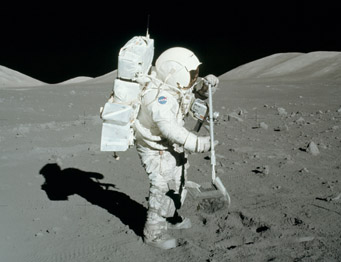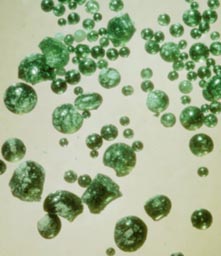I looked up "dry" in the dictionary, and a picture of the Moon wasn't next to it. But there should have been one.

Astronaut Harrison "Jack" Schmitt uses a special rake to collect lunar soil during the Apollo 17 mission in December 1972.
NASA
Geochemists have painstakingly picked over lunar samples from the Apollo missions for nearly 40 years, and no one's ever turned up even the slightest hint of water or minerals altered by water. Nada, zip, zilch. Based on all available evidence, your average lunar rock contains no water down to less than one part per billion. Arguably, our Moon is the driest body in the solar system.
Here's why: when a planet-size body careened into Earth 4½ billion years ago, the smash-up sent a superheated cloud of debris temporarily into orbit. Some of that collected into what became the Moon, but not before all the water escaped from it as white-hot vapor.
Now, there might be patches of water ice hidden in permanently shadowed crater floors at the lunar poles. But that doesn't really count — those icy reservoirs, if they truly exist, resulted from comets and water-enriched asteroids crashing in the Moon much more recently.

These small beads of green volcanic glass, collected by the crew of Apollo 15, contain a tiny trace of water.
NASA
You know the old saying "Never say never"? Today, at a meeting of lunar and planetary specialists, Alberto Saal (Brown University) announced that he and his research team have found trace amounts of water in an unusual sample returned by Apollo 15 astronauts. They analyzed little beads of a rare volcanic glass that erupted onto the lunar surface from a fire fountain billions of years ago.
These peculiar green-glass particles have been studied many times before, but researchers didn't find any water in them because no one's had an instrument sensitive enough to detect it until recently. Saal reports that the glass beads contain water at up to 30 parts per million. That's still just 0.003%. He thinks there might have been at least 10 times more water in the lava before it erupted, but that's more speculative.
So does this mean future astronauts can simply squeeze some rocks when they get thirsty? No, but Saal argues that models of the Moon's chemical and thermal evolution should now take the presence of water into account. You can read the technical description of his experiment here.
 2
2
Comments
Grant Martin
March 15, 2008 at 9:01 pm
Is there any possibility these beads could have been splattered off the earth by an impact? It would account for the trace amounts of water. also, have the beads in fact been dated, or is the "billions of years ago" mentioned in the article just a guesstimate? If they are indeed terrestrial in origin, they could be used to date a huge impact on earth.
You must be logged in to post a comment.
Fred
March 30, 2008 at 3:57 am
So far we only have lunar soil samples from 6 lunar missions. Not exactly a great set of samples on which to base the hunt for water on the moon.
NASA is sending a lunar orbiter up shortly which may give a few more answers.
Till then...
You must be logged in to post a comment.
You must be logged in to post a comment.